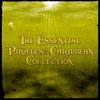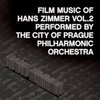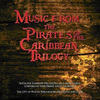Soundtrack Information

Pirates of the Caribbean: At World's End
Walt Disney Records (D000037102)
Release Date: May 22, 2007
Conducted by Blake Neely / Nick Glennie-Smith
Performed by
The Hollywood Studio Symphony
Formats: CD, Digital
Music By
Purchase Soundtrack
Track Listing
Related Albums

The World of Hans Zimmer - A Symphonic CelebrationSony Classical
Released: March 15, 2019
Formats: CD, Digital, Vinyl (117 min)

The Music of Hans Zimmer: The Definitive CollectionSilva (SILCD1453)
Released: July 28, 2014
Formats: CD, Digital (361 min)

The Essential Pirates of the Caribbean CollectionSilva Screen Records, Ltd.
Released: October 11, 2011
Format: Digital (81 min)

Film Music of Hans Zimmer - Vol. 2Silva Screen (SILED1362)
Released: August 16, 2011
Formats: CD, Digital (102 min)

Pirates of the Caribbean: Soundtrack Treasures CollectionCollector's Edition
Walt Disney Records (D000102400)Released: December 4, 2007
Format: CD (235 min)

Music from The Pirates of the Caribbean TrilogySilva Screen Records, Ltd. (SILCD 1241)
Released: September 25, 2007
Format: CD (63 min)

Pirates of the Caribbean: At World's End RemixesWalt Disney Records
Released: May 22, 2007
Format: Digital (26 min)
Review: Pirates of the Caribbean: At World\'s End
4.5 / 5 Stars
Pirates of the Caribbean: The Curse of the Black Pearl unknowingly set the stage for an intricate franchise in terms of plots, characters, and musical themes. The original score was written quickly by numerous composers and was heavily mixed with synthesizers. This gave the score a very direct structure with memorable theme after theme being thrown on screen without any subtlety. The result of this was the creation of a hugely successful score and the foundation for better scores to follow. Pirates of the Caribbean: Dead Man\'s Chest, with Hans Zimmer now officially at the reigns, did two things: rework elements of the first film\'s score into a more intricate, diverse, and complex score, this time with a full orchestra, and expand upon the Curse of the Black Pearl foundation with a number of new themes. The epic nature of this film franchise leads fans to wonder what the finale will bring. For Pirates of the Caribbean: At World\'s End, Zimmer brings to bear the full arsenal of themes and musical ideas from the first two films to create a whirlpool of action-packed, heroic score in a level of thematic complexity that is astounding. This review will only scratch the surface.
I have struggled over how to structure this review. Readers can view SoundtrackNet\'s First Listen for what each track contains, so I will examine the score in two ways: how certain themes are used and developed through the score, and how this album ranks in the grand scheme of Hans Zimmer\'s past works. More than having a large number of themes weaving in and out of the score, Zimmer wrote two new themes: the Love Theme, and the Pirate Theme (based around the song "Hoist the Colours"), both of which are very long and broken up into multiple segments. This leads to a level of thematic complexity that rivals most other franchises. Surprising are the few prominent themes from the first two films that were not included, at least on the soundtrack. Foremost among these is the moving cello theme from the first film that was fully orchestrated for the final scene of Dead Man\'s Chest. Due to its prominence in the first two films, this was a surprise. Other themes, such as the Black Pearl Theme and Tia Dalma\'s Theme, appear once or twice on the album, but no more than expected as new, more important themes rise to the foreground.
The first theme I want to discuss is first introduced in the opening track in the form of the song "Hoist the Colours". This is, basically, the Pirate Theme and has multiple parts to it, which can be identified by following the progression of the song, beginning with the boy through the addition of the male chorus. I call this the "Pirate Theme" because one of the main elements of At World\'s End is the addition of new pirate characters that unite against the East India Trading Company in the film. When one thinks about it, there really weren\'t many real pirates in the first two films. Curse of the Black Pearl featured an "undead" crew and the renegade Jack Sparrow, who didn\'t even have a ship. In Dead Man\'s Chest, I don\'t recall any actual piracy occurring, just chasing and being chased by Davy Jones. So finally, we get to see a greater expanse of the pirate\'s world in At World\'s End. This is expressed with the Pirate Theme as one of the major thematic focal points of the score. Additionally, this theme - along with the even more central Love Theme - brings the swashbuckling element to the score that even critics of the first two probably will enjoy.
Curse of the Black Pearl was heavily criticized by certain film score fans for two reasons: that is was mixed heavily with synth, and that it lacked the swashbuckling quality of other pirate films, such as Cutthroat Island. At World\'s End corrects both these issues. Curse of the Black Pearl could even be said to be the "synth mockup" of this score, at least in regard to the original themes - they sound better and are further fleshed out in their orchestrations. In fact, some of the brass performances during the action sequences are simply stunning. So what is swashbuckling anyway? It basically means action-packed, but here, I suppose it means in regard to pirate films. Cutthroat Island remains the prime example of a modern swashbuckling score, though Zimmer himself has achieved this sound once before in Muppet Treasure Island. The two new themes - the Pirates Theme and the Love Theme - are well suited for being adapted to action scenes and are done so often. The best example is the cue "Up Is Down" which actually sounds a bit like the Muppet Treasure Island main title. While this score does lack the orchestral bombast and countless triumphant fanfares of Cutthroat Island, Zimmer makes an amazingly good attempt at creating a soundscape suitable for the pirate world. In this score, he utilizes harpsichord and other instruments that give parts of the score a certain period feel. In addition, Zimmer, for probably the first time in a Bruckheimer production, uses prominent woodwinds often, giving this score a much wider spectrum of orchestration that even Cutthroat Island did not boast. Bits of choir behind the action sequences ("What Shall We Die For") further flesh out the score.
Okay, so back to the Pirate Theme. "Hoist the Colours" introduces the two main elements of this theme, the first sung by a boy, the second by a male choir; this latter part is the theme\'s main part and is varied in its statements throughout the score. This theme is not used until halfway through the album where it gets its first orchestral statements in "The Brethren Court". The orchestral variation of the melody, especially when backed by choir, reminds me of James Dooley\'s choir theme from SOCOM: U.S. Navy SEALs Combined Assault. It is used in the middle of this cue and is followed by a quirky statement of the melody by an accordion and recorder, adding to the "period" feel of the score. This theme returns in "What Shall We Die For" with a drawn out version of the main Pirates Theme variation. The choir comes in singing the lyrics to "Hoist the Colours" for a nice, epic reprise. The other use of this theme on the album is interspersed with the Love Theme and "He\'s A Pirate" rhythms during the second half of the major action sequence of "I Don\'t Think Now is the Best Time" where the subtheme based on the boy\'s portion of the song returns.
Now for the complicated part of the score: the Love Theme (which is basically the film\'s main theme). This was a huge melodic suite that Zimmer broke up into multiple parts for various purposes of the score. This way it gets very nice statements and also very loud, bold statements for action scenes. The theme, as a whole as well as its individual parts, is extremely versatile and this characteristic is utilized in full. Love Theme A is heard first in "At Wit\'s End" in a quiet French horn solo. Love Theme B is a descending motif, kind of like the dark motif from "Anakin\'s Dark Deeds" in Star Wars: Episode III - Revenge of the Sith. This is hinted at in "At Wit\'s End" between A statements and then in full a bit later on. The motif version of this theme is the descending notes, the full version has a melodic pattern not unlike the heroic theme from The Last Samurai, which follows the ethereal vocals in "At Wit\'s End" beneath a high string countermelody, which I will return to. In the last segment of this cue, Zimmer introduces an action motif based on Love Theme B, which is also a descending three note melody, like the beginning of his theme for Batman in Batman Begins.
The theme(s) comes back in "Up Is Down" in a fast-paced cue, which has a moving ostinato string line that follows the melodic pattern of the theme. Love Theme A is performed by the brass over this line. The cue ends with the B action motif. Zimmer flips around some of the note patterns in this cue, hence the title. Most themes in the Pirates trilogy start with the same three ascending notes, but here Zimmer puts them in a descending pattern. For the Love Theme B motifs as well, which descend, this gives At World\'s End a darker, more epic feel, which is appropriate for the final film, as Williams did for Revenge of the Sith. To drastically simplify, Love Theme B is the descending second half to the ascending Love Theme A. At least in certain forms, of which there are many. Love Theme A is also performed on a solo oboe at the start of "I See Dead People in Boats" (what an awesome track title!), a sound that is relatively unheard of to date in Bruckheimer productions. Then, more at home for Bruckheimer, Love Theme A gets a Morricone-influenced statement in heavy guitar in "Parlay". Yes, this sounds like Broken Arrow, but that was an ode to Morricone too!
Toward the end of "I See Dead People in Boats", we are introduced to a drawn out melodic version of the Love Theme B, which could be considered a C Theme. This only returns a few times on the album, mainly as a huge orchestral moment at the end of "I Don\'t Think Now is the Best Time". This finale action sequence cue is the culmination of all the themes and features both the Love and Pirate Themes, in most of their variations, interspersed with various Jack Sparrow themes as well. What is interesting about this chaotic theme conglomeration is that a fast short-string ostinato keeps a steady pace through the entire sequence, kind of like the action climax from King Arthur. The final two tracks on the album are big orchestral conclusion cues featuring the Love Themes. "One Day" opens with a series of brass chords over a moving string line in a near identical pattern to the wedding scene at the end of King Arthur, as Jack\'s Heroic Theme from the first film is played over it. Then, in order, Love Themes A, B, and C are stated in full. These three are stated again in "Drink Up Me Hearties", which sounds like an end credits suite.
I have mentioned in a couple previous reviews (such as The Island) that there has been a certain trend in recent scores from Zimmer\'s studio that feature a style that utilizes an underlying moving string line. King Arthur, Batman Begins, and The Da Vinci Code are good examples of this. With At World\'s End, Zimmer takes this further - as he did with a number of things with this score - and adds a new level of complexity to it. An example is the ostinato line from "Up Is Down", which is later used as a backing rhythm to the final theme statements in "Drink Up Me Hearties". "I Don\'t Think Now is the Best Time" contains a moving line under the majority of the 10+ minute track in a style like "Hello Beastie" from Dead Man\'s Chest. In the first part of this cue, the moving line is an ostinato variation of Beckett\'s Theme (aka the East India Trading Company Theme) from the second film. Alternately, there is a moving string countermelody, ascending/descending, that is played over Love Theme B on a number of occasions, first in "At Wit\'s End" and then prominently at the end of both of the last two tracks. This countermelody almost takes on a life as a stand-alone motif in two places. First, it is stated dramatically by the low brass directly after the Love Theme C statement and then again at the very end of "One Day" by a flute, as a fading away afterthought.
I know, I need to wrap this up! Those are the major themes and we haven\'t hit on the smaller ones. The multiple Jack Sparrow themes by this point are used frequently, unlike in Dead Man\'s Chest, but are generally interspersed within statements of other themes. The action motifs from the cave scene in Curse of the Black Pearl appear at the end of "I Don\'t Think Now is the Best Time" as well. The new pirate character, Sao Feng (Chow Yun Fat), gets a new theme, which is most apparent in the "Singapore" cue played on the erhu and has a sound style similar to parts of The Last Samurai. I do want to just mention the uses of my favorite theme from the franchise, which is for Davy Jones. His music box/organ theme from Dead Man\'s Chest is stated briefly again with chimes in "At Wit\'s End" before the theme gets a new arrangement for Jones\' more action-based sequences in this film. Following the music box statement, we get a full orchestral statement which possesses more power than those from Dead Man\'s Chest. This theme returns at the beginning of "I Don\'t Think Now is the Best Time" in a militaristic style which actually sounds a lot like the main theme to The Rock. Beckett\'s Theme is heard throughout the score, but with a new brass melody, often in relation to either Davy Jones\' Theme or Sao Feng\'s ("Singapore"). It is also given a tragic choral quality in the final action sequence ("I Don\'t Think Now is the Best Time").
Okay, I\'m almost done. Clearly I like this score. Hans Zimmer has upped the ante for action scores by utilizing hugely complex themes, full orchestra and choir, electronic and ethnic elements, and multiple solo instruments like accordion, erhu, harpsichord, banjo and music box. This franchise has come a long way from the original score, even when compared to the change from postmodern to epic choir in the Matrix trilogy. I think this score has all the elements a modern pirate film needs and finally stands up to Cutthroat Island. I know it\'s early, but this is one of the best scores of the year.
Soundtrack.Net Articles
-
Click stars
to rate.
If any information appears to be missing from this page, contact us and let us know!